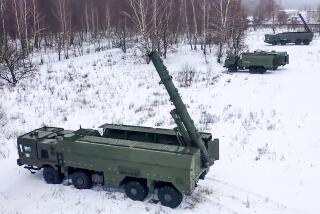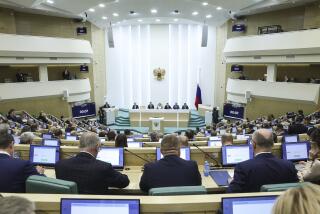Soviets’ Mock Nuclear Accident Alert Termed a Disaster in Itself
MOSCOW — The sirens wailed just after noon in the city of Balakovo, the site of a nuclear power station about 600 miles southeast of Moscow.
Loudspeakers issued ominous public warnings. Firefighters in protective clothing raced to the power station and swung into action. The police halted traffic and ordered people off the streets.
But virtually no one knew where the fallout shelters were, and only one shelter out of 70 was adequately stocked with food, water and bedding.
Wild rumors began to sweep through the city’s 120,000 people, and a shop manager snatched a dozen bottles of vodka to face the emergency. City officials, unprepared for the situation, wrung their hands and tried to shift responsibility to others.
Thirty minutes after it began, the alert was canceled. It was not another Chernobyl-type explosion and fire, but only the Soviet Union’s first civil defense exercise to deal with a simulated nuclear accident.
Lack of Preparations
The newspaper Soviet Russia, reporting all this Wednesday, clearly regarded it as a civil defense disaster. Without saying when the exercise took place, it criticized the city’s lack of preparations and noted that city officials had had six months’ warning.
Still, the newspaper’s account of the incident indicated that at least some of the lessons of Chernobyl had been learned by civil defense specialists at Balakovo, where one nuclear reactor is operating and several others are under construction.
The firefighters, for example, were equipped with radiation-resistant clothing and special equipment for dealing with a reactor on fire. In Chernobyl, where a reactor exploded and burst into flame in April, 1986, many firemen died after hours of exposure to radiation because they lacked such protection.
In contrast to the long period of silence that followed the Chernobyl explosion, the fire chief on duty instantly reported the simulated accident to all responsible authorities.
A radiation detection squad was able to report immediately on levels of radioactivity, again in contrast to the lack of usable measuring devices at Chernobyl.
Finally, five minutes after the simulated accident was announced, the public was informed over loudspeakers. People were ordered indoors to avoid radiation.
In the town of Pripyat, three miles from the Chernobyl reactor, officials gave the 50,000 people no radiation warning for nearly 36 hours.
Yuri Burov, the Soviet Russia reporter who wrote the Balakovo article, said the people who planned the exercise were in some ways unhappy with the results.
For example, he said, not everyone heard the alarm because there were too few sirens and too few loudspeakers. A large majority, he said, had no idea where the basements designated as fallout shelters were situated, and only one of the 70 shelters had been prepared.
The monitoring of radioactivity was well organized, he said, but the city officials were not able to understand the meaning of the readings.
Residents were blamed for spreading rumors that the Balakovo reactor was so defective that people would have to spend the rest of their lives in basements. Other rumors suggested that city officials were only pretending that this was a test, in order to conceal a worse reality.
Emergency headquarters was so poorly equipped, Burov said, that it could not function properly.
‘Pathetic in Their Inability’
“City officials were pathetic in their inability to do anything constructive,” he went on, adding that they expected to be relieved of their duties in the event of a real nuclear accident.
Reporting on the mock evacuation, Burov said that there was no plan for moving residents out of the city and that the evacuation had to be improvised. Further, he said, there was no provision for moving invalids and older people and none for dealing with the difficulties created by the separation of families.
“The most organized part of the population proved to be tots from kindergartens,” Burov said. “Each child had an identifying tag and a gauze mask over the mouth and nose.”
On the other hand, he said, adults tried to avoid the evacuation by leaving their apartments or going to the movies, with the result that only a few people boarded the 30 evacuation buses, most of them without documents, food, drink or any sort of protective clothing.
Relief teams from nearby cities arrived “as if for a picnic, without protective clothing or equipment, clad in jogging suits and house slippers,” he said, adding:
“Civil defense, essentially brigades of people who are supposed to protect themselves under the leadership of specialists and experts, proved totally incapable of the task.”
More to Read
Sign up for Essential California
The most important California stories and recommendations in your inbox every morning.
You may occasionally receive promotional content from the Los Angeles Times.










